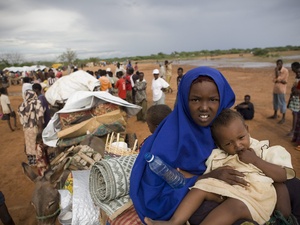Humanitarian assistance severely hampered by ongoing Mogadishu fighting amid fears of spreading famine
Humanitarian assistance severely hampered by ongoing Mogadishu fighting amid fears of spreading famine
In Somalia, our head of office in Mogadishu has just completed a five-week tour of duty in the Somali capital, where she witnessed the spontaneous development of settlements for internally displaced people (IDPs) across the city as Somalis uprooted by drought and famine flocked there in search of assistance. She updated colleagues as UNHCR makes preparations to deliver assistance to up to 180,000 people in Mogadishu and south central Somalia by the month's end. However, at the same time, our ability to deliver that much needed aid is being hampered by the ongoing fighting in the Somali capital.
There were already over 370,000 internally displaced people in Mogadishu before the recent drought- and famine-related displacement, which has driven some 100,000 more desperate people into the war-ravaged city. This increase can be traced back to mid-June when our Population Movement Tracking (PMT) partners recorded a sharp increase in the numbers fleeing to Mogadishu. In July alone, over 27,000 people were displaced into Mogadishu from the surrounding areas, mainly Bay, Bakool and Lower Shabelle, all heavily drought-affected areas. Almost as many people have fled to Mogadishu in just one month (27,100) as were displaced in the entire first quarter of this year (31,400).
According to the latest data from our food security partners, given the current levels of malnutrition, mortality and humanitarian response, in combination with the likelihood of increasing prices and a harsh dry season, food security is expected to deteriorate over the coming months. By August / September, all regions of southern Somalia are likely to be facing famine, according to Food Security and Nutrition Analysis Unit's Famine Early Warning System Network (FEWS NET), and it's expected that the influx of IDPs into the city will continue.
This news could not come at a more difficult time. The ongoing offensive is negatively affecting the ability of UNHCR and other partners to deliver assistance to populations in distress at a time when their needs are most urgent. We need to maintain access to these people. Our staff's only means of travel in Mogadishu is in heavily armoured vehicles protected by security escorts. As a result of restrictions on these escorts due to the ongoing fighting in the capital, our ability to move around Mogadishu has been severely limited. This comes just as UNHCR was embarking on protection assessment missions in up to 10 settlements across the city to better provide assistance and services to those in need. The results of a recent protection assessment in Badbaado settlement, home to an estimated 28,000 people, will be known this week.
Despite the long drought, some areas have recently been hit by torrential rains, including around the capital over the weekend. The rain contributed to the misery of many IDPs. UNHCR will distribute plastic sheeting in the city over the next week.
So far, we have distributed over 15,000 emergency assistance packages (EAPs) for some 90,000 people in Mogadishu and southern Somalia since the declaration of the famine in two regions on 20 July. We plan to distribute a further 13,000 EAPs to benefit some 78,000 people in the coming 10 days. Security situation permitting, shelter staff will soon be in Mogadishu to strengthen the coordination of partners distributing shelter and related emergency items (plastic tarpaulins, kitchen sets, sleeping mats and blankets etc). They will also assess warehouse capacity as UNHCR prepares to receive a number of airlifts of relief items from its emergency stockpile in Dubai and other donor sources in the coming and weeks.
In Kenya, meanwhile, the flow of refugees from Somalia continues unabated, with more than 40,000 Somalis arriving in the sprawling Dadaab refugee camps in July, the highest monthly arrival rate in the camp's 20-year history. A total of 40,434 Somalis arrived in Dadaab during the month.
So far this year, some 116,000 Somali refugees have streamed into the complex of camps, already the largest and most congested in the world. In the last two months alone, Dadaab has received some 71,000 new refugees, at an average rate of 1,300 per day in July.
In order to ease the overcrowding at the edges of two of the camps, UNHCR is continuing its operation to relocate refugees to two new sites. The relocation of refugee families from the outskirts of Ifo refugee camp in Dadaad to the new Ifo Extension is progressing well, with some 1,500 people moved every day. By today, some 10,000 people will have been relocated by UNHCR and its partners. The relocation will continue until an estimated 90,000 people are moved. Meanwhile, a second site, at Kambioos, is being prepared for refugee families to start moving from Hagadera camp in the next few days.
Learn more about the crisis in Somalia and how to contribute by visiting the UNHCR Horn of Africa emergency site. For the latest updates follow us on Facebook or Twitter.
For further information on this topic, please contact:
-
In Geneva: Fatoumata Lejeune-Kaba on mobile: +41 79 249 3483
-
In Nairobi UNHCR regional office: Ron Redmond on mobile +254 734 564 019
-
In Nairobi UNHCR regional office: Needa Jehu-Hoyah on mobile +254 734 564 018
-
In Nairobi UNHCR Kenya office: Emmanuel Nyabera on mobile: +254 773 995 975
-
In Dadaab camp, Kenya: William Spindler on mobile +254 71 545 5992
-
In Kenya, UNHCR Somalia Office: Andy Needham on mobile +254 733 120 931
-
In Ethiopia: Milicent Mutuli on mobile +251 911 207 906
-
In Ethiopia: Kisut Gebre Egziabher on mobile +251 911 208 901





